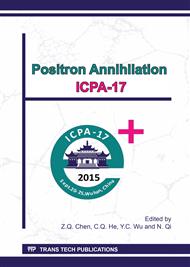[1]
S. Berko, Positron Annihilation in Ferromagnetic Solids, in: A. T. Stewart and L. O. Roellig (Eds. ), Positron Annihilation, Academic Press, New York, 1967, pp.61-79.
DOI: 10.1016/b978-0-12-395497-8.50008-4
Google Scholar
[2]
A. Kawasuso, M. Maekawa, Y. Fukaya, A. Yabuuchi, and I. Mochizuki, Phys. Rev. B83 (2011)100406(R).
Google Scholar
[3]
A. Kawasuso, M. Maekawa, Y. Fukaya, A. Yabuuchi and I. Mochizuki, Phys. Rev. B85 (2012)024417.
Google Scholar
[4]
S. Berko and A. P. Mills, J. Phys. Colloques 32(1971) C1-287.
Google Scholar
[5]
D. W. Gidley and A. R. Koymen, Phys. Rev. Lett. 49(1982)1779.
Google Scholar
[6]
A. Kawasuso, Y. Fukaya, M. Maekawa, H. Zhang, T. Seki, T. Yoshino, E. Saitoh, K. Takanashi, J. Mag. Mag. Mater. 342(2013)139.
Google Scholar
[7]
H. J. Zhang, S. Yamamoto, Y. Fukaya, M. Maekawa, H. Li, A. Kawasuso, T. Seki, E. Saitoh& K. Takanashi, Scientific Reports 4, (2014) 04844.
DOI: 10.1038/srep04844
Google Scholar
[8]
H. J. Zhang, S. Yamamoto, B. Gu, H. Li, M. Maekawa, Y. Fukaya, and A. Kawasuso Phys. Rev. Lett. 114(2015)166602.
Google Scholar
[9]
H. Li, M. Maekawa, A. Kawasuso and N. TanimuraJ. Phys. Condens. Matter 27(2015)246001.
Google Scholar
[10]
X. Gonze et al., Comput. Mater. Sci. 25(2002)478.
Google Scholar
[11]
P. E. Blöchl, Phys. Rev. B 50(1994)17953.
Google Scholar
[12]
E. Boroński and R. M. Nieminen, Phys. Rev. B 34(1986)3820.
Google Scholar
[13]
S. Wakoh and J. Yamashita, J. Phys. Soc. Jpn. 21(1966)1712.
Google Scholar
[14]
S. Ishida, S. Fujii, S. Kashiwagi and S. Asano, J. Phys. Soc. Jpn. 64(1995)2152.
Google Scholar
[15]
Y. Miura, K. Nagao and M. Shirai, Phys. Rev. B69(2004)144413.
Google Scholar
[16]
K. E. H. M. Hanssen, P. E. Mijnarends, L. P. L. M. Rabou, K. H. J. Buschow, Phys. Rev. B42(1990)1533.
Google Scholar
[17]
C. H. Park, B. C. Lee and J. I. Lee, J. Kor. Phys. Soc. 47(2005)655.
Google Scholar
[18]
A. Held and S. Kahana, Can. J. Phys. 42(1964)(1908).
Google Scholar
[19]
E. Wimmer, A. J. Freeman and H. Krakauer, Phys. Rev. B30(1984)3113.
Google Scholar
[20]
R. Wu and A. J. Freeman, Phys. Rev. Lett. 69(1992)2867.
Google Scholar


